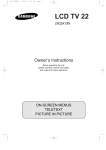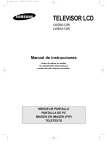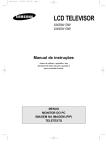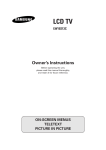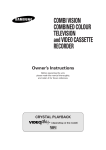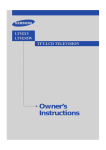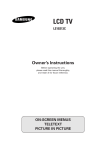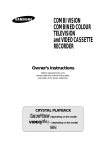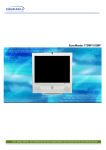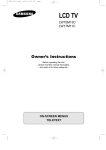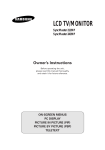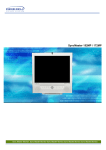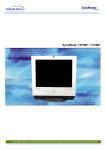Download Samsung LW29A13W User Manual
Transcript
LW29A13W_40A13W_en 4/23/03 10:06 AM Page 1 LCD TV LW29A13W LW40A13W Owner’s Instructions Before operating the unit, please read this manual thoroughly, and retain it for future reference. ON-SCREEN MENUS PC DISPLAY PICTURE IN PICTURE (PIP) TELETEXT LW29A13W_40A13W_en 4/23/03 10:06 AM Page 2 Caution CAUTION RISK OF ELECTRIC SHOCK DO NOT OPEN CAUTION: TO PREVENT ELECTRICAL SHOCK, DO NOT REMOVE REAR COVER, NO USER SERVICEABLE PARTS INSIDE. REFER SERVICING TO QUALIFIED SERVICE PERSONNEL. The lightning flash and arrow head within the triangle is a warning sign alerting you of “dangerous voltage” inside the product. The exclamation point within the triangle is a warning sign alerting you of important instructions accompanying the product. WARNING: TO PREVENT DAMAGE WHICH MAY RESULT IN FIRE OR SHOCK HAZARD, DO NOT EXPOSE THIS APPLIANCE TO RAIN OR MOISTURE. ☛ The main voltage is indicated on the rear of your set and the frequency is 50 or 60 Hz. Information in this document is subject to change without notice. © 2003 Samsung Electronics Co., Ltd. All rights reserved. Reproduction in any manner whatsoever without the written permission of Samsung Electronics Co., Ltd. is strictly forbidden. Samsung Electronics Co., Ltd. shall not be liable for errors contained herein or for incidental or consequential damages in connection with the furnishing, performance, or use of this material. The Samsung logo is the registered trademarks of Samsung Electronics Co., Ltd.; Microsoft, Windows® and Windows® NT are registered trademark of Microsoft Corporation; VESA, DPMS and DDC are registered trademarks of Video Electronics Standard Association. All other product names mentioned herein may be the trademarks or registered trademarks of their respective owners. Plug and Play The adoption of the new VESA® Plug and Play solution eliminates complicated and time consuming setup. It allows you to install your set in a Plug and Play compatible system without the usual hassles and confusion. Your computer system can easily identify and configure itself for use with your set. Your set automatically tells the computer system its Extended Display Identification Data (EDID) using Display Data Channel (DDC) protocols so the computer system can automatically configure itself to use your set. PowerSaver This set is EPA Energy Star® compliant and NUTEK compliant when used with a computer equipped with VESA DPMS functionality. For energy conservation, turn your set Off when you are not using it or when leaving it unattended for long periods. European Notice (Europe Only) Products with the CE Marking comply with both the EMC Directive (89/336/EEC), (92/31/EEC), (93/68/EEC) and the Low Voltage Directive (73/23/EEC) issued by the Commission of the European Community. Compliance with these directives implies conformity to the following European Norms: ■ EN55022:1998+A1:2000 - Radio Frequency Interference ■ EN55024:1998 - Electromagnetic Immunity ■ EN55013:1990+A12:1994+A13:1996+A14:1999 - Radio Frequency Interference ■ EN55020:1994+A11:1996+A12/A13/A14:1999 - Electromagnetic Immunity ■ EN61000-3-2:1995+A1/A2:1998 - Power Line Harmonics ■ EN61000-3-3:1995 - Voltage Fluctuations ■ EN60065:1997 or EN60095:1998 - Product Safety English-2 BN68-00275J-00Eng 9/25/03 6:20 PM Page 3 Safety Instructions These illustrations represent precautions concerning your set. 75% 10% 35` Do NOT expose your set to extreme temperature or humidity conditions. H H 5` Do NOT expose your set to direct sunlight. Do NOT expose your set to any liquids. If your set is broken, do not try to repair it yourself. Contact qualified service personnel. During storm conditions (especially when there is lightning) unplug your set from the mains socket and aerial. Keep all power adaptors apart. Possible fire hazard. Always keep the power adaptor in a well-ventilated area. Remove and discard the plastic cover from the power adaptor before use. Possible fire hazard. Keep the power adaptor away from any other heater. Possible fire hazard. If the remote control is not used for a long period of time, remove the batteries and store it in a cool, dry place. THIS DEVICE IS NOT FOR USE IN INDUSTRIAL ENVIRONMENTS Please use a soft and dry cloth (not containing volatile matter) when you clean the TV. English-3 LW29A13W_40A13W_en 4/23/03 10:06 AM Page 4 Contents ◆ FOREWORD ■ ■ Caution .......................................................................................................... Safety Instructions .......................................................................................... 2 3 ◆ CONNECTING AND PREPARING YOUR TV ■ ■ ■ ■ ■ ■ ■ ■ ■ Viewing the Control Panel ............................................................................. Viewing the Connection Panel ....................................................................... - Connecting an Aerial or Cable Television Network .................................... - Connecting External A/V Devices ............................................................... - Connecting Set-Top Box, VCR, or DVD...................................................... - Connecting Computer................................................................................. - Connecting Sound Outputs ......................................................................... - Connecting Digital Audio Inputs................................................................. - Connecting Speakers................................................................................... Viewing Pictures From External Sources......................................................... Viewing the Remote Control (All Functions Except Teletext) .......................... Viewing the Remote Control (Teletext Functions)........................................... Inserting the Batteries in the Remote Control.................................................. Switching On and Off .................................................................................... Becoming Familiar with the Remote Control.................................................. Choosing Your Language................................................................................ ◆ SETTING ■ ■ ■ ■ ■ ■ ◆ USING ■ ■ ■ ■ ■ ■ ■ ■ English-4 THE CHANNELS Storing Channels Automatically...................................................................... Storing Channels Manually............................................................................. Giving Channels Names................................................................................. Skipping Unwanted Channels ........................................................................ Fine Tuning Channel Reception ..................................................................... Sorting the Stored Channels ........................................................................... THE 6 7 8 8 8 8 8 9 9 9 10 11 12 12 13 14 15 16 18 19 19 20 VARIOUS FUNCTIONS Changing the Picture Standard ....................................................................... Adjusting the Picture Settings ......................................................................... Selecting the Picture Format........................................................................... Freezing the Current Picture........................................................................... Changing the Sound Standard ........................................................................ Adjusting the Sound Settings .......................................................................... Enjoying the Dolby Sound (LW29A13W) ....................................................... Switching the Internal Woofers On/Off (LW29A13W).................................... 21 21 22 22 23 23 24 24 LW29A13W_40A13W_en 9/19/03 4:55 PM Page 5 Contents ◆ USING ■ ■ ■ ■ ■ ■ ■ ■ ■ ◆ USING ■ ■ ■ ■ ■ ■ ■ ■ ◆ USING ■ ■ ■ ■ THE VARIOUS FUNCTIONS Setting the External Digital Sound (LW40A13W)............................................ Setting the Dolby Digital (LW40A13W).......................................................... Setting the Dolby Pro-Logic (LW40A13W) ..................................................... Selecting the Sound Mode.............................................................................. Viewing the Picture In Picture (PIP)................................................................ Selecting the Sleep Timer ............................................................................... Setting and Displaying the Current Time ........................................................ Switching the Television On and Off Automatically....................................... DNIe (Digital Natural Image engine) ............................................................. THE PC FUNCTIONS Setting up Your PC Softerware (Based on Windows 2000 or XP).................... Adjusting the Contrast and Brightness ............................................................ Selecting the Image Size................................................................................. Adjusting the Image Quality........................................................................... Changing the Image Position.......................................................................... Adjusting the Colour ...................................................................................... Initializing the Image Settings......................................................................... Adjusting the PC Screen Automatically .......................................................... THE 25 26 27 28 29 31 32 33 34 35 36 36 37 37 38 39 39 TELETEXT FEATURE Teletext Feature.............................................................................................. Displaying the Teletext Information................................................................ Selecting Display Options .............................................................................. Selecting a Teletext Page................................................................................ 40 41 41 42 ◆ RECOMMENDATIONS FOR USE ■ ■ ■ ■ ■ Troubleshooting: Before Contacting Service Personnel................................... PowerSaver .................................................................................................... Technical and Environmental Specifications .................................................. Display Modes ............................................................................................... Wiring the Mains Power Supply Plug (UK Only) ............................................ Symbols Press ☛ ➢ Important Note 43 44 45 46 47 English-5 LW29A13W_40A13W_en 4/23/03 10:07 AM Page 6 Viewing the Control Panel 1 (Power) Turns ON/OFF your set. 2 Power Indicator 3 Remote Control Sensor 4 TV/VIDEO Displays a menu of all of the available input sources(TV, VIDEO, S-VIDEO, EXT1, EXT2, PC Analog, PC Digital). English-6 5 MENU Opens the OSD and selects the function. 6 ▼ C/P. ▲ Moves the selector up or down on the OSD. Increases or decreases the channel number. Switches on the TV when it is in Standby mode. + 7 Moves the selector left or right on the OSD. Increases or decreases the level of audio volume and the values of the selected function. LW29A13W_40A13W_en 4/23/03 10:07 AM Page 7 Viewing the Connection Panel LW29A13W 7 8 1 3 2 5 4 Power Input LW40A13W 6 5 ☛ Whenever you connect an audio or video system to your set, ensure that all elements are switched off. Refer to the documentation supplied with your equipment for detailed connection instructions and associated safety precautions. English-7 LW29A13W_40A13W_en 4/23/03 10:07 AM Page 8 Viewing the Connection Panel 1 Connecting an Aerial or Cable Television Network To view television channels correctly, a signal must be received by the set from one of the following sources: - An outdoor aerial - A cable television network - A satellite network 2 Connecting External A/V Devices - Connect RCA or S-VIDEO cable to an appropriate external A/V device such as VCR, DVD, or Camcorder. - Connect RCA audio cables to “AUDIO(L)” and “AUDIO(R)” on the rear of your set and the other ends to corresponding audio out connectors on the A/V device. - Headphone may be connected to the headphone output ( ) on the rear of your set. While the headphone is connected, the sound from the built-in speakers will be disabled. 3 Connecting Set-Top Box, VCR, or DVD - Connect the VCR, or DVD EXT cable to the EXT connector of the VCR, or DVD. - If you wish to connect both the Set-Top Box and VCR (or DVD), you should connect the Set-Top Box to the VCR (or DVD) and connect the VCR (or DVD) to your set. 4 Connecting Computer - Connect the DVI connector to the PC video connector. - Connect the stereo audio cable to ”PC AUDIO(ST)” on the rear of your set and the other end to “Audio Out” of the sound card on your computer. ➣ 5 DVI connector Pin Description Pin Description 1 2 3 4 5 6 7 8 9 10 11 12 13 14 15 Rx 2Rx 2+ Grounding No connection No connection DDC Clock (SCL) DDC Data (SDA) Analog Vertical Sync Rx 1Rx 1+ Grounding No connection No connection DDC Input Power (+5V) Self Laster 16 17 18 19 20 21 22 23 24 25(C3) 26(C5) 27(C4) 28(C2) 29(C5) 30(C1) Output Signal Connection Rx 0Rx 0+ Grounding No connection No connection Grounding Rx CRx C+ Analog (Blue) Analog Grounding Analog Horizontal sync. Analog (Green) Analog Grounding Analog (Red) Connecting Sound Outputs Connect RCA audio cables to an audio system or external amplifier. English-8 LW29A13W_40A13W_en 4/23/03 10:07 AM Page 9 Viewing the Connection Panel 6 Connecting Digital Audio Inputs Connect RCA audio cables to a equipment with a digital output (to take digital sound). Connecting Speakers (depending on the model) 7 Connect the speaker audio cable to the external speaker output jack on the rear of your set making sure that the +, - polarities are correctly aligned. ➢ The speakers MUST have more than 7watts rating (impedance 8Ω). or Mount the brackets on the speaker and your set. Connect the speaker and your set using screws. Viewing Pictures From External Sources Once you have connected up your various audio and video systems, you can view the different sources by selecting the appropriate input. 1 Check that all the necessary connections have been made (refer to pages 8 and 9 for further details). 2 Switch your set on and if necessary, press the VIDEO button repeatedly. The input sources are displayed in the following order: TV - VIDEO - S-VIDEO - Ext1 - Ext2 - PC Analog - PC Digital. ➣ To watch television programme again, press the TV button. English-9 LW29A13W_40A13W_en 4/23/03 10:07 AM Page 10 Viewing the Remote Control (All Functions Except Teletext) Automatic switch-off VCR/DVD Functions: - Stop - Rewind - Play/Pause - Fast-Forward Television On/Off Numeric buttons for direct channel access Picture freeze (Not Available in PC mode) PIP Picture-In-Picture Functions: - PIP On/Off - PIP size selection (SIZE) - PIP channel selection (P▲/▼) (Not available for LW29A13W) - Interchange the main and sub picture (SWAP) - PIP freeze (STILL) : Not available - PIP location selection (LOCATE) - PIP channel scan (SCAN) - PIP source selection (TV/VIDEO) Make the remote control work for TV, VCR, Cable, DVD player. One/Two-digit channel selection On-screen display TV mode selection directly Next channel Volume decrease Temporary sound switch-off Available sources selection Menu display/ Exit from the OSD Volume increase Previous channel Sound mode selection Picture size selection Picture menu display Not available Picture effect selection Sound menu display Sound effect selection ➣ English-10 The performance of the remote control may be affected by bright light. LW29A13W_40A13W_en 4/23/03 10:07 AM Page 11 Viewing the Remote Control (Teletext Functions) Not available PIP Teletext hold Teletext reveal Teletext index Teletext display/ Mix both teletext information and the normal broadcast Teletext sub-page Teletext size selection Fastext topic selection English-11 LW29A13W_40A13W_en 4/23/03 10:07 AM Page 12 Inserting the Batteries in the Remote Control You must insert or replace the batteries in the remote control when you: ◆ Purchase your set ◆ Find that the remote control is no longer operating correctly 1 Remove the cover on the rear of the remote control by pressing the symbol downwards and then pulling firmly to remove it. 2 Insert two R03, UM4, “AAA” 1.5V or equivalent batteries taking care to respect the polarities: ◆ + on the battery against + on the remote control ◆ - on the battery against - on the remote control 3 Replace the cover by aligning it with the base of the remote control and pressing it back into place. ➣ Do not mix battery types, i.e. alkaline and monganese. Switching On and Off The mains lead is attached to the rear of your set. ☛ If you have purchased this set in the United Kingdom, refer to page 45 for further instructions on plug wiring. 1 Plug the mains lead into an appropriate socket. A green Standby indicator appears on the front of your set. Result: 2 Press the POWER ( ) or channel up/down (P / , ▼C/P. ▲) button. The screen is turned on and a green Standby indicator Result: disappears on the front of your set. Your set can be placed in Standby mode, in order to reduce the power consumption. The Standby mode can be useful when you wish to interrupt viewing temporarily (during a meal, for example). 1 Press the POWER ( ) button. Result: The screen is turned off and a green Standby indicator appears on the front of your set. 2 To switch your set back on, simply press the POWER ( again. ➣ English-12 ) button Do not leave your set in Standby mode for long periods of time (when you are away on holiday, for example). Turn your set off by unpluging from the mains and aerial. LW29A13W_40A13W_en 4/23/03 10:07 AM Page 13 Becoming Familiar with the Remote Control The remote control is used mainly to: ◆ Change channels and adjust the volume ◆ Set up your set using the on-screen menu system The following table presents the most frequently used buttons and their functions. PIP Button Viewing Function Menu Function Used to display the next stored channel. Used to select the previous menu option. P Used to display the previous stored channel. Used to select the next menu option. to Used to display the corresponding channels. P -/-- MUTE Used to select a channel numbered ten or over. Press this button, and the “--” symbol is displayed. Enter the two-digit channel number. Used to decrease the volume. Used to... ◆ Display a submenu containing selections for the current menu option. ◆ Search forwards manually for channels ◆ Reduce a menu option value. Used to increase the volume. Used to... ◆ Display a submenu containing selections for the current menu option. ◆ Search backwards manually for channels ◆ Increase a menu option value. Used to switch the sound off temporarily. ➣ MENU To turn the sound back on, press this button again, + button. - or or press the Used to display the on-screen menu system. Used to return to the previous menu or normal viewing. English-13 LW29A13W_40A13W_en 4/23/03 10:07 AM Page 14 Choosing Your Language When you start using your set for the first time, you must select the language which will be used for displaying menus and indications. 1 Press the MENU button. Result: 2 Press the P Result: Function Time PIP Language DNIe English Off English-14 The main menu is displayed. or P button to select the Function. The options available in the Function group are displayed. + button. 3 Press the 4 Press the P 5 Select a particular language by pressing the repeatedly. 6 When you are satisfied with your choice, press the MENU button to return to normal viewing. - or or P button to select the Language. - or + button LW29A13W_40A13W_en 4/23/03 10:07 AM Page 15 Storing Channels Automatically You can scan for the frequency ranges available to you (and availability depends on your country). Automatically allocated programme numbers may not correspond to actual or desired programme numbers. However you can sort numbers manually and clear any channels you do not wish to watch. 1 Channel Auto store Manual store Name Add/Erase Fine tune Channel sort Press the MENU button. Result: The main menu is displayed. Channel 2 Press the P Result: 3 Press the Result: 4 Press the Result: or P button to select the Channel. The options available in the Channel group are displayed. - or The Auto store is selected. - or + button again. The options available in the Auto store group are displayed when the Country is selected. + button repeatedly. - or Select your country by pressing the The following countries are available: Belgie - Deutschland - Espania - France - Italia - Nederland - Schweiz - Sverige - UK - East Europe. 6 Press the P - or the ➣ 7 UK + button. 5 Result: Country Search Channel Country Search UK or P button to select the Search, and then press + button. The search will end automatically. Channels are sorted and stored in an order which reflects their position in the frequency range, (with lowest first and highest last). The programme originally selected is then displayed. Search Program Frequency Band 1 205MHz VHF-H To stop the search before it has finished, press the MENU button. When the channels have been stored, you can: ◆ Change channels ◆ Assign a name to the stored channels (refer to page 18) ◆ Clear a channel (refer to page 19) ◆ Fine tune channel reception if necessary (refer to page 19) ◆ Sort them in the order required (refer to page 20) English-15 LW29A13W_40A13W_en 4/23/03 10:07 AM Page 16 Storing Channels Manually (continued) Channel Auto store Manual store Name Add/Erase Fine tune Channel sort You can store up to 100 channels, including those received via cable networks. When storing channels manually, you can choose: ◆ Whether or not to store each of the channels found ◆ The programme number of each stored channel which you wish to identify 1 Channel Colour system Sound system Search Channel Program LNA Store AUTO BG 0MHz C 1 P 1 Off ? Channel Colour system Sound system Search Channel Program LNA Store AUTO BG 0MHz C 1 P 1 Off ? Press the MENU button. Result: 2 Press the P Result: 4 Press the P or P - or Press the Result: 5 English-16 6 button to select the Channel. The options available in the Channel group are displayed. Press the - or + button. button to select the Manual store. + button. The options available in the Manual store group are displayed with the Colour system is selected. If necessary, indicate the broadcasting standard required by pressing + button repeatedly. - or the Result: AUTO BG 0MHz C 1 P 1 Off ? or P 3 Channel Colour system Sound system Search Channel Program LNA Store The main menu is displayed. The colour standards are displayed in the following order: AUTO - PAL - SECAM - NT4.43. Press the P or P button to select the Sound system. Indicate + button - or the sound standard required by pressing the repeatedly. Result: The sound standards are displayed in the following order: BG - DK - I - L. LW29A13W_40A13W_en 4/23/03 10:07 AM Page 17 Storing Channels Manually Channel Colour system Sound system Search Channel Program LNA Store 7 If you know the channel number to be stored, press the P or P button to select the Channel. Indicate the required number by + button. - or pressing the If you do not know the channel numbers, press the P button to select the Search. + button. - or Start the search by pressing the Result: 8 9 Press the P or P button to select the LNA.(LW40A13W) + button. - or Select the On by pressing the Amplifies signals when antenna reception is poor. However if incoming signals are interfering with each other, turn off LNA as it may malfuction. Press the P or P button to select the Store. + button. - or Select the OK by pressing the Result: 11 The tuner scans the frequency range until the first channel or the channel that you selected is received on your screen. To assign a programme number to a channel, select the Program by pressing the P or P button. + button to find the correct number. - or Press the Result: 10 or P The channel and associated programme number are stored. Repeat Steps 7 to 9 for each channel to be stored. AUTO BG 0MHz C 1 P 1 Off ? Channel Colour system Sound system Search Channel Program LNA Store AUTO BG 0MHz C 1 P 1 Off ? Channel Colour system Sound system Search Channel Program LNA Store AUTO BG 0MHz C 1 P 1 ON ? Channel Colour system Sound system Search Channel Program LNA Store English-17 AUTO BG 0MHz C 1 P 1 ON ? LW29A13W_40A13W_en 4/23/03 10:07 AM Page 18 Giving Channels Names If channel name information is broadcast when you store the channels either manually or automatically, the names are assigned to the channels directly. You can however change these names or assign new names as required. 1 Press the MENU button. Result: 2 Press the P Result: or P button to select the Channel. The options available in the Channel group are displayed. 3 Press the 4 Press the P or P - or Press the Result: English-18 The main menu is displayed. - or + button. button to select the Name. + button. The current channels are displayed. 5 If necessary, select the channel to be assigned to a new name by pressing the P or P button. 6 Press the 7 Press the P or P button to select a letter (A~Z), a number (0~9) or a symbol (-, space). Move on the previous or next letter by + button. - or pressing the 8 Repeat Steps 5 to 7 for each channel to be assigned to a new name. - or + button. LW29A13W_40A13W_en 4/23/03 10:07 AM Page 19 Skipping Unwanted Channels You can exclude the channels you chosen from the channels you scanned. When you scan through the stored channels, those you have chosen to skip are not displayed. All channels that you do not specifically choose to skip are displayed during scanning. 1 Press the MENU button. Result: 2 Press the P Result: The main menu is displayed. or P The options available in the Channel group are displayed. 3 Press the 4 Press the P or P - or Press the Result: button to select the Channel. - or + button. button to select the Add/Erase. + button. The stored channels are displayed. 5 Press the P or P button to select the channel to add or erase. If necessary, select the Added or Erased by pressing the + button. - or 6 Repeat Step 5 for each channel to be added or erased. Fine Tuning Channel Reception If the reception is clear, you do not have to fine-tune the channel, as this is done automatically during the search and store operation. If however the signal is weak or distorted, you may have to fine-tune the channel manually. 1 Press the MENU button. Result: 2 Press the P Result: Channel Auto store Manual store Name Add/Erase Fine tune Channel sort The main menu is displayed. or P button to select the Channel. Fine tune The options available in the Channel group are displayed. + button. 3 Press the 4 Press the P 5 Obtain a sharp and clear picture and good sound quality by pressing + button. - or the - or or P + 1 button to select the Fine tune. English-19 LW29A13W_40A13W_en 4/23/03 10:07 AM Page 20 Sorting the Stored Channels Channel You can exchange the numbers of two channels, in order to: ◆ Modify the numeric order in which the channels have been automatically stored. Auto store Manual store Name Add/Erase Fine tune Channel sort ◆ Give easily remembered numbers to the channels that you watch most often. 1 Result: Channel sort From To Store P 1 ----P-? 2 P 1 ----P 3 ----? Channel sort From To Store The main menu is displayed. or P Press the 4 Press the P or P - or Press the Result: button to select the Channel. The options available in the Channel group are displayed. 3 - or + button. button to select the Channel sort. + button. The options available in the Channel sort group are displayed with the From is selected. 5 Select the channel number that you wish to change by pressing the + button repeatedly. - or 6 Press the P or P button to select the To. Select the new number by which you wish to identify the channel by pressing the + button repeatedly. - or 7 Press the P or P button to select the Store. Select the OK to confirm the exchange of channel numbers by pressing the + button. - or P 3 ----P 1 ----OK Result: 8 English-20 Press the P Result: Channel sort From To Store Press the MENU button. The selected channel is exchanged with the one previously stored to the chosen number. For all the channels to move to the required channel numbers, repeat steps 5 to 7 after select the From by pressing the P or P button. LW29A13W_40A13W_en 4/23/03 10:07 AM Page 21 Changing the Picture Standard You can select the type of picture which best corresponds to your viewing requirements. 1 Press the MENU button. The main menu is displayed. Result: 2 Press the P or P button to select the Picture. The options available in the Picture group are displayed. Result: ➣ Picture Mode Custom Contrast Brightness Sharpness Colour Colour tone Normal You can also display simply by pressing the P.MENU (Picture Menu) button. 3 + button. - or Press the The Mode is selected. Result: 4 + - or Select the required picture effect by pressing the button repeatedly. The following picture effects are available: Dynamic - Standard - Movie - Custom ➣ ➣ You can also set these options simply by pressing the P.STD (Picture Standard) button. On the Picture menu, if you change the Contrast, Brightness, Sharpness, Colour or Tint (NTSC only) settings, the Custom is selected automatically. Adjusting the Picture Settings Your set has several settings which allow you to control picture quality. 1 Press the MENU button. The main menu is displayed. Result: 2 Press the P or P button to select the Picture. The options available in the Picture group are displayed. Result: Press the 4 Select the option (Contrast, Brightness, Sharpness, Colour or Tint-NTSC only) to be adjusted by pressing the P or P + button. - or button. Press the The horizontal bar is displayed. Result: + button to reach the required setting. 5 Press the 6 Press the P or P button to select the Colour tone. Select the + button repeatedly. - or required option by pressing the the The following options are available: - or Cool2 - Cool1 - Normal - Warm1 - Warm2. ➣ Colour tone Normal + button. 3 - or Picture Mode Custom Contrast Brightness Sharpness Colour Contrast 70 Picture Mode Custom Contrast Brightness Sharpness Colour Colour tone If you make any changes to these settings, the picture standard is automatically switched to Custom. English-21 Normal LW29A13W_40A13W_en 4/23/03 10:07 AM Page 22 Selecting the Picture Format You can select the picture format which best corresponds to your viewing requirements simply by pressing the “P.SIZE” (Picture Size) button. The following picture formats are available: ◆ 16:9 Sets the Normal picture in 16:9 Wide mode. ◆ Panorama Sets the picture in 16:9 Wide mode so that it can be shown like the Normal picture. ◆ Zoom 1 Expands the 4:3 aspect ratio screen size. ◆ Zoom 2 Expands the Zoom 1 screen size. ◆ 4:3 Setting for normal 4:3 format. ◆ Auto Wide The screen size is automatically adjusted when entering a PAL Plus signal(WSS). ➣ ◆ This feature does not work while the PIP feature is activating ◆ When the picture size is selected to 16:9, the PIP feature will work. Freezing the Current Picture ➣ Not Available in PC mode. Press the “STILL PICTURE” button on the remote control to freeze the picture on a given frame. When PIP is active, PIP screen is also frozen. To return to normal viewing, press the “STILL PICTURE” button again. PIP English-22 LW29A13W_40A13W_en 4/23/03 10:07 AM Page 23 Changing the Sound Standard You can select the type of special sound effect to be used when watching a given broadcast. 1 The main menu is displayed. Press the P Result: ➣ 3 or P button to select the Sound. The options available in the Sound group are displayed. You can also display simply by pressing the S.MENU (Sound Menu) button. - or Press the Result: 4 Custom Press the MENU button. Result: 2 Sound Mode Bass Treble + button. The Mode is selected. + - or Select the required sound effect by pressing the button repeatedly. The following sound effects are available: Custom - Standard - Music - Movie - Speech. ➣ You can also set these options simply by pressing the S.STD (Sound Standard) button. Adjusting the Sound Settings The sound settings can be adjusted to suit your personal preferences. 1 Press the MENU button. Result: 2 Press the P Result: Sound Mode Bass Treble Custom The main menu is displayed. or P button to select the Sound. The options available in the Sound group are displayed. + button. 3 Press the 4 Select the option (Bass or Treble) to be adjusted by pressing the + button. - or P or P button. Press the - or Bass 47 Result: 5 Press the ➣ The horizontal bar is displayed. - or + button to reach the required setting. If you make any changes to these settings, the sound standard is automatically switched to Custom. English-23 LW29A13W_40A13W_en 4/23/03 10:07 AM Page 24 Enjoying the Dolby Sound (LW29A13W) Sound Mode Bass Treble Dolby Woofer Custom : : On Off This feature provides a home theater-like Dolby effect by mixing the left and right speakers. 1 Press the MENU button. Result: 2 Press the P Result: The main menu is displayed. or P button to select the Sound. The options available in the Sound group are displayed. + button. 3 Press the 4 Press the P 5 For enjoying the Dolby sound effect, select the On by pressing the + button. - or - or or P button to select the Dolby. Switching the Internal Woofers On/Off (LW29A13W) Sound Mode Bass Treble Dolby Woofer Custom : : On On When the internal woofers are switched off, all the sound is routed to the external woofers. 1 Press the MENU button. Result: 2 Press the P Result: English-24 The main menu is displayed. or P button to select the Sound. The options available in the Sound group are displayed. + button. 3 Press the 4 Press the P 5 Select the On to be routed the sound to the internal woofers by + button. - or pressing the - or or P button to select the Woofer. LW29A13W_40A13W_en 4/23/03 10:07 AM Page 25 Setting the External Digital Sound (LW40A13W) You can enjoy Digital sound when the equipment with Digital output is connected to the television. 1 Press the MENU button. The main menu is displayed. Result: 2 Press the P or P button to select the Sound. The options available in the Sound group are displayed. Result: 3 Press the 4 Press the P or P button to select the Ext. audio. + button. - or Press the The Ext. audio menu is displayed. Result: 5 Select the required output (EXT1, EXT2, S-video or Video) by + button. - or pressing the 6 Select the option (Analog, Optical or Coaxial) by pressing + button. - or the - or + button. 7 Press the MENU button. The options available in the Sound group are displayed Result: again. 8 Press the P 9 Select the required option (Volume or Fixed) by pressing + button. - or the or P button to select the Audio out. ◆ If you want to adjust the volume level with the volume control on the TV or external amplifier, set to Volume. ◆ If you set to Fixed... - You can adjust the volume level with the volume control on the audio amplifier. And the Int. mute is set to On automatically, and you can not select it. - The following controls are not available: volume, bass, treble, and speaker setting. 10 Press the P or P button to select the Int. mute. If you set to On, no sound outputs of all internal and external speakers. ➢ Rear of the TV When the Audio out is set to Volume, you can select the Int. mute and control it. Coaxial Analog Optical Sound Mode Custom Bass Treble Ext. audio Audio out Volume Int. mute Off Dolby Digital Sound EXT1 EXT2 S-video Video Analog Analog Analog Analog Sound Mode Custom Bass Treble Ext. audio Audio out Volume Int. mute Off Dolby Digital Sound Mode Custom Bass Treble Ext. audio Audio out Volume Int. mute On Dolby Digital English-25 LW29A13W_40A13W_en 4/23/03 10:07 AM Page 26 Setting the Dolby Digital (LW40A13W) You can enjoy Digital sound when the equipment with Digital output is connected to the television. Rear of the TV Sound Mode Custom Bass Treble Ext. audio Audio out Volume Int. mute Off Dolby Digital Sound Pro Logic : Dynamic range : Speaker set Press the MENU button. The main menu is displayed. Result: 2 Press the P or P button to select the Sound. The options available in the Sound group are displayed. Result: 3 Press the 4 Press the P or P button to select the Dolby Digital. + button. - or Press the The Dolby Digital menu is displayed with the Result: Pro Logic is selected. 5 Select the option (Auto, On or Off) by pressing the + button. - or ➢ Pro Logic : Dynamic range : Speaker set On On Sound Pro Logic : Dynamic range : Speaker set On On Sound Left Test tone On Size : Large Volume: 0dB Delay : - or + button. For further details of output depending on the each options, refer to following page. 6 Press the P or P button to select the Dynamic range. If you wish to adjust the volume properly during night viewing, select the On + button. - or by pressing the 7 Press the P or P button to select the Speaker setting. + button. - or Press the The Speaker Setting menu is displayed with the main Result: left speaker is selected. 8 Select the speaker (Left, Center, Right, Right Rear, Left Rear, Woofer) to be adjusted by pressing the P or P button. 9 Depending on the speaker, the following settings can be adjusted to suit your personal preferences. ◆ Test tone to simulate the volume (On or Off) ◆ Size (Large, Small or Off) ◆ Volume level (-10dB ~ 10dB) ◆ delay time of surround channel (0 ~ 15ms) : When the Right Rear or Left Rear is selected, you can adjust. On Off Sound English-26 1 LW29A13W_40A13W_en 4/23/03 10:07 AM Page 27 Setting the Dolby Pro Logic (LW40A13W) In case of “Pro Logic : Auto” Output Input (Source) Main Left Center Main Right Surround Right Left Sub Woofer Mono ✔ ✔ PCM Stereo (L/R) ✔ ✔ Mono ✔ ✔ Lo/Ro ✔ ✔ Lt/Rt ✔ ✔ ✔ ✔ ✔ 5.1ch ✔ ✔ ✔ ✔ ✔ ✔ DTS ✔ ✔ ✔ ✔ ✔ ✔ MPEG I (Stereo only) ✔ MPEG II ✔ ✔ ✔ ✔ ✔ ✔ Main Left Center Main Right Right Left ✔ ✔ ✔ Dolby Digital ✔ In case of “Pro Logic : On” Output Input (Source) Mono Surround Sub Woofer ✔ PCM Stereo (L/R) ✔ Mono ✔ ✔ Lo/Ro ✔ ✔ ✔ ✔ ✔ Lt/Rt ✔ ✔ ✔ ✔ ✔ 5.1ch ✔ ✔ ✔ ✔ ✔ ✔ DTS ✔ ✔ ✔ ✔ ✔ ✔ MPEG I (Stereo only) ✔ ✔ ✔ ✔ ✔ MPEG II ✔ ✔ ✔ ✔ ✔ Main Left Center Main Right Dolby Digital ✔ In case of “Pro Logic : Off” Output Input (Source) Mono PCM Stereo (L/R) ✔ ✔ Surround Right Left Sub Woofer ✔ ✔ Mono ✔ ✔ Lo/Ro ✔ ✔ Lt/Rt ✔ ✔ 5.1ch ✔ ✔ ✔ ✔ ✔ ✔ DTS ✔ ✔ ✔ ✔ ✔ ✔ MPEG I (Stereo only) ✔ MPEG II ✔ ✔ ✔ ✔ Dolby Digital ➣ ✔ ✔ ✔ The output of Sub Woofer is changed depending on the speaker setting. English-27 LW29A13W_40A13W_en 4/23/03 10:07 AM Page 28 Selecting the Sound Mode The “S.MODE” button displays/controls the processing and output of the audio signal. When power is switched on, the mode is automatically preset to either “Dual-I ” or “Stereo”, depending on the current transmission. Regular broadcast (Standard audio) MONO (Normal use) Regular + NICAM Mono MONO ↔ MONO NICAM (Normal) NICAM Stereo STEREO ↔ MONO NICAM (Normal) NICAM Dual-I/II Dual-I → Dual-II → MONO NICAM NICAM (Normal) A2 Stereo Regular broadcast (Standard audio) MONO (Normal use) Bilingual or Dual-I/II DUAL-I ↔ DUAL-II Stereo ➣ → On-screen indication → NICAM Stereo Type of broadcast STEREO ↔ MONO (Forced mono) ◆ If the receiving conditions deteriorate, listening will be easier if the mode is set to the MONO. ◆ If the stereo signal is weak and an automatic switching occurs, then switch to the MONO. ◆ When receiving a mono sound in the AV mode, connect to the “AUDIO (L)” input connector on the rear panel. English-28 LW29A13W_40A13W_en 4/23/03 10:07 AM Page 29 Viewing the Picture In Picture (PIP) (continued) You can display a sub picture within the main picture of TV program or external A/V devices such as VCR or DVD. In this way you can watch TV program the video input from any connected devices while watching TV or other video input. 1 Press the P Result: The main menu is displayed. or P Press the 4 Press the P or P - or Press the Result: - or + button. On Video Small Main - or + button. You can also activate the PIP simply by pressing the PIP ON button. To deactivate the PIP, press it again. Result: The sources are displayed in the following order (depending on the model): TV (LW40A13W) - Video - S-Video - EXT1 - EXT2. 7 : The options available in the PIP group are displayed. Press the P or P button to select the TV/Video. Select a + button. - or source of the sub picture by pressing the ➣ Function PIP TV/Video Size Locate Swap Sound sel button to select the PIP. + button. Select the On by pressing the ➣ 6 button to select the Function. The options available in the Function group are displayed. 3 5 English off Press the MENU button. Result: 2 Function Time PIP Language DNIe Function PIP TV/Video Size Locate Swap Sound sel : On Video Small Main You can also select these options simply by pressing the TV/VIDEO button. Press the P or P button to select the Size. Select a size of + button. - or the sub picture by pressing the Result: The sizes are displayed in the following order: Small - Double ➣ You can also select these options simply by pressing the SIZE button. Function PIP TV/Video Size Locate Swap Sound sel : PIP English-29 On Video Small Main LW29A13W_40A13W_en 4/23/03 10:07 AM Page 30 Viewing the Picture In Picture (PIP) Function PIP TV/Video Size Locate Swap Sound sel : On Video Small Main 8 Press the P or P button to select the Locate. Move the sub + button. picture counterclockwise by pressing the ➣ ◆ When the size of sub picture is set to Double, this feature does not work. ◆ You can also move the sub picture simply by pressing the LOCATE button. 9 Press the P Pressing the Function PIP TV/Video Size Locate Swap Sound sel : Result: On Video Small Main ➣ 10 or P - or button to select the Swap. + button. The main picture and the sub picture are interchanged. You can also select these options simply by pressing the SWAP button. Press the P or P button to select the Sound sel. To hear the + - or sound of sub picture, select the Sub by pressing the button. Result: The options are displayed in the following order: Main - Sub Function PIP TV/Video Size Locate Swap Sound sel : PIP English-30 On Video Small Main ➣ ◆ P▼/▲ button : Used to select the channel of sub picture. ◆ SCAN button : Used to scan every memorized channel in order. To stop scanning, press it again. LW29A13W_40A13W_en 4/23/03 10:07 AM Page 31 Selecting the Sleep timer You can select a time period of between 10 and 240 minutes after your set automatically switches off. 1 Press the P Result: 3 Press the Result: 4 Press the Result: 5 English off Press the MENU button. Result: 2 Function Time PIP Language DNIe The main menu is displayed. or P button to select the Function. The options available in the Function group are displayed. - or + button. The Time is selected. - or Function Time Setting Clock On time Off time Sleep timer + button again. The Time Setting menu is displayed. Press the P or P button to select the Sleep timer. Select the number of minutes after which your set switches off by pressing the + button repeatedly. - or ◆ The preset time intervals: 10, 20, 30, 60, 90, 120, 150, 180, 210, and 240 minutes. PIP ➣ You can also select simply by pressing the “SLEEP” button. If the sleep timer is already set, the screen displays the remaining time and then your set will be switched off. If the sleep timer is not yet set, displays Off. English-31 09:37 06:00 On 23:30 On Off LW29A13W_40A13W_en 4/23/03 10:07 AM Page 32 Setting and Displaying the Current Time Function Time PIP Language DNIe You can set the television’s clock so that the current time is display by pressing the “DISPLAY” button. You must also set the time if you wish switch the television on or off automatically at the time you select. English off ➣ 1 09:35 24:00 Off 24:00 Off Off Press the MENU button. Result: Function Time Setting Clock On time Off time Sleep timer If you disconnect the power cord and re-connect it, the clock will be reset to the default value. 2 Press the P Result: 3 Press the Result: 4 Press the Result: 5 or P button to select the Function. The options available in the Function group are displayed. - or + button. The Time is selected. - or + button again. The Time Setting menu is displayed with Clock is selected. + button to move to the hour or minute. - or Press the Set the hour or minute by pressing the P or P button. ➣ English-32 The main menu is displayed. You can view the setting status of selected source by pressing the “DISPLAY” button on the remote control. LW29A13W_40A13W_en 4/23/03 10:07 AM Page 33 Switching the Television On and Off Automatically You can switch the television on or off automatically at the time you select. ➣ 1 The first step is to set the television’s clock (refer to “Setting and Displaying the Current Time” on the previous page). Press the P Result: 3 Press the Result: 4 Press the Result: 5 The main menu is displayed. or P button to select the Function. The options available in the Function group are displayed. - or + button. Function Time Setting Clock On time Off time Sleep timer 09:36 06:00 On 24:00 Off Off The Time is selected. - or + button again. The Time Setting menu is displayed. Press the P or P button to select On time. Set the time at which you wish the television to be switched on automatically. + button to move to the hour, minute or - or ◆ Press the on/off. Set these by pressing the P or P button. 6 English off Press the MENU button. Result: 2 Function Time PIP Language DNIe Function Time Setting Clock On time Off time Sleep timer Press the P or P button to select Off time. In the same above, set the time at which you wish the television to be switched off automatically. English-33 09:37 06:00 On 23:30 On Off LW29A13W_40A13W_en 4/23/03 10:07 AM Page 34 DNIe (Digital Natural Image engine) Function Time PIP Language DNIe English off Samsung’s New Technology bring you more detailed image with contrast enhancement and white enhancement. New image compensation algorithm gives brighter, cleare, to our customers. DNIe technology will fit every signals into your eyes. 1 Press the MENU button. Result: 2 Press the P Result: 3 The main menu is displayed. or P button to select the Function. The options available in the Function group are displayed. Press the P or P button to select the DNIe. - or Select the required option by pressing the the repeatedly. The following options are available: + button Off - Medium - High - Demo English-34 ◆ Off Switches off the DNIe mode. ◆ Medium Switches on the DNIe mode. ◆ High The screen is more clear than in Medium. ◆ Demo The screen before applying DNIe appears on the right and the screen after applying DNIe appears on the left. BN68-00275J-00Eng 9/19/03 5:15 PM Page 35 Setting up Your PC Software (Based on Widows 2000 or XP) The Windows display-settings for a typical computer are shown below. But the actual screens on your PC will probably be different, depending upon your particular version of Windows and your particular video card. But even if your actual screens look different, the same, basic set-up information will apply in almost all cases. (If not, contact your computer manufacturer or Samsung Dealer.) 1 First, click on “Settings” on the Windows start menu. While “Settings” is highlighted, move the cursor so that “Control Panel” is highlighted. 2 When the control panel screen appears, click on “Display” and a display dialogbox will appear. box 3 Navigate to the “Settings” tab on the display dialog-box. The correct setting of size (resolution) - 1280 x 768 pixels If a vertical-frequency option exists on your display settings dialog box, the correct value is “60” or “60 Hz”. Otherwise, just click “OK” and exit the dialog box. English-35 LW29A13W_40A13W_en 4/23/03 10:07 AM Page 36 Adjusting the Contrast and Brightness ➣ PC Image Image lock Position Colour adjust Recall Auto adjustment 1024x768 48.2kHz 59.9Hz 1 Press the MENU button. Result: 2 Press the Result: PC 4 Contrast 75 Press the Result: Expand 1 The main menu is displayed. Press the P Result: 3 Image Contrast Brightness Size Preset to the PC mode by pressing the VIDEO button. or P button to select the PC. The options available in the PC group are displayed. - or + button. The Image is selected. - or + button again. The options available in the Image group are displayed. 5 Select the option (Contrast or Brightness) to be adjusted for the colour of your computer image by pressing the P or P button. + button. - or Press the Result: The horizontal bar is displayed. In Digital mode, the Brightness can be only adjusted. 6 Press the - or + button to reach the required setting. Selecting the Image Size ➣ PC Image Contrast Brightness Size 1 Preset to the PC mode by pressing the VIDEO button. This function doesn’t work in Digital input. Press the MENU button. Result: Expand 1 2 Press the P Result: 3 Press the Result: 4 Press the Result: 5 or P button to select the PC. The options available in the PC group are displayed. - or + button. The Image is selected. - or + button again. The options available in the Image group are displayed. Press the P or P button to select the Size. Select a size of + button. - or the your computer image by pressing the Result: ➣ English-36 The main menu is displayed. The sizes are displayed in the following order: Expand 1 - Expand 2 - Normal. You can also select these options simply by pressing the P.SIZE (Picture Size) button. LW29A13W_40A13W_en 4/23/03 10:07 AM Page 37 Adjusting the Image Quality ➣ Preset to the PC mode by pressing the VIDEO button. This function doesn’t work in Digital input. This feature is used to fine tune and get the best image by removing noises that create unstable images with jitters and shimmers. 1 Press the MENU button. Result: 2 Press the P Result: The main menu is displayed. or P The options available in the PC group are displayed. 3 Press the 4 Press the P or P - or Press the Result: 5 - or + button. button to select the Image lock. + button. Press the ➣ PC Image lock Coarse Fine The options available in the Image lock group are displayed. Select the option (Coarse or Fine) to be adjusted for the quality of your computer image by pressing the P or P button. + button. - or Press the Result: 6 button to select the PC. PC Image Image lock Position Colour adjust Recall Auto adjustment 1024x768 48.2kHz 59.9Hz Coarse 1344 The horizontal bar is displayed. - or + button to reach the required setting. This feature may change the width of the image. If necessary, adjust the position to center. Changing the Image Position ➣ 1 Preset to the PC mode by pressing the VIDEO button. This function doesn’t work in Digital input. Press the MENU button. Result: 2 Press the P Result: The main menu is displayed. or P The options available in the PC group are displayed. 3 Press the 4 Press the P or P - or Press the 5 - or + button. button to select the Position. + button. Select the position (H-Position or V-Position) to be adjusted by + button. - or pressing the P or P button. Press the Result: 6 button to select the PC. Press the PC Image Image lock Position Colour adjust Recall Auto adjustment 1024x768 48.2kHz 59.9Hz PC Position H-Position V-Position The horizontal bar is displayed. - or + button to reach the required setting. H-Position 50 English-37 LW29A13W_40A13W_en 4/23/03 10:07 AM Page 38 Adjusting the Colour ➣ PC Image Image lock Position Colour adjust Recall Auto adjustment 1024x768 48.2kHz 59.9Hz PC Mode R G B 1 Press the MENU button. Result: 2 Press the P Result: Press the P or P - or Press the - or + button. button to select the Colour adjust. + button. The options available in the Colour adjust group are displayed with the Mode is selected. + 5 - or Select the required colour mode by pressing the button repeatedly. the following colour modes are available. Custom - Colour 1 - Colour 2 - Colour 3 6 If you wish adjust the colour which best corresponds to you viewing requirements, select the option (R-Red, G-Green or B-Blue) to be adjusted by pressing the P or P button. + button. - or Press the Result: 7 ➣ English-38 button to select the PC. The options available in the PC group are displayed. 4 Custom 100 or P Press the Result: R The main menu is displayed. 3 Custom PC Mode R G B Preset to the PC mode by pressing the VIDEO button. This function doesn’t work in Digital input. Press the The horizontal bar is displayed. - or + button to reach the required setting. If you change the R(Red) G(Green)or B(Blue) setting, the Mode is selected to Custom automatically. LW29A13W_40A13W_en 4/23/03 10:07 AM Page 39 Initializing the Image Settings ➣ Preset to the PC mode by pressing the VIDEO button. You can replace all image settings with the factory default values. 1 Press the MENU button. Result: 2 Press the P Result: 3 4 Press the or P button to select the PC. The options available in the PC group are displayed. - or Press the P or P - or Press the Result: 5 The main menu is displayed. PC Image Image lock Position Colour adjust Recall Auto adjustment 1024x768 48.2kHz 59.9Hz + button. button to select the Recall. + button. PC Recall Image recall Colour recall The options available in the Recall group are displayed. Select the option (Image recall or Colour recall) to be replaced + button. - or by pressing the P or P button. Press the Result: The screen becomes black and return to original view about a few seconds later. In Digital input, the Colour recall can be only adjusted. Adjusting the PC Screen Automatically ➣ 1 Preset to the PC mode by pressing the VIDEO button. This function doesn’t work in Digital input. Press the MENU button. Result: 2 Press the P Result: The main menu is displayed. or P The options available in the PC group are displayed. 3 Press the 4 Press the P or P - or Press the Result: button to select the PC. - or PC Image Image lock Position Colour adjust Recall Auto adjustment 1024x768 48.2kHz 59.9Hz + button. button to select the Auto adjustment. + button. The screen quality and position are automatically adjusted, and the screen returns to original view about a few seconds later. Auto adjustment Please wait English-39 LW29A13W_40A13W_en 4/23/03 10:07 AM Page 40 Teletext Feature Most television channels provide written information services via teletext. Information provided includes: ◆ Television programme times ◆ News bulletins and weather forecasts ◆ Sports results ◆ Travel information This information is divided into numbered pages (see diagram). Part Contents A Selected page number. B Broadcasting channel identity. C Current page number or search indications. D Date and time. E Text. F Status information. FASTEXT information. ➣ Teletext information is often divided between several pages displayed in sequence, which can be accessed by: ◆ Entering the page number ◆ Selecting a title in a list ◆ Selecting a coloured heading (FASTEXT system) English-40 LW29A13W_40A13W_en 4/23/03 10:07 AM Page 41 Displaying the Teletext Information You can display Teletext information at any time on your set. ☛ For Teletext information to be displayed correctly, channel reception must be stable; otherwise: ◆ Information may be missing ◆ Some pages may not be displayed 1 Select the channel providing the Teletext service by pressing the P or P button. 2 Press the TTX/MIX button to activate the teletext mode. Result: The contents page is displayed. It can be redisplayed at any time by pressing the (index) button. 3 Press the TTX/MIX button again. The screen will be split into two. This Double Teletext Result: feature lets you view the actual broadcast and teletext information separately on the screen. 4 If you wish to display the actual broadcast and teletext information on a single screen, press the TTX/MIX button again. 5 Press the TV button again to exit from the teletext display. Selecting Display Options When you have displayed a Teletext page, you can select various options to suit your requirements. To display... Press the... ◆ Both teletext information and the normal broadcast TTX/MIX twice ◆ Hidden text (answers to quiz games, for example) (reveal) ◆ The normal screen (reveal) again ◆ A secondary page, by entering its 4-digit number ◆ Double-size letters in the: • Upper half of the screen • Lower half of the screen • Once • Twice ◆ Normal screen • Three times English-41 LW29A13W_40A13W_en 4/23/03 10:07 AM Page 42 Selecting a Teletext Page The various topics included in the teletext pages are colour-coded, and can be selected by pressing the coloured buttons on the remote control. 1 Enter the three-digit page number given in the content by pressing the corresponding numeric buttons. Result: English-42 The current page counter is incremented and the page is then displayed. If the selected page is linked with several secondary pages, the secondarypages are displayed in sequence. To stop the given page acquisition press the ( )(hold) button. Press the ( )(hold) button again to resume. 2 If the FASTEXT system is used by the broadcasting company, the different topics covered on a Teletext page are colour-coded and can be selected by pressing the coloured buttons on the remote control. Press the coloured button corresponding to the topic that you wish to select; the available topics are given on the status line. Result: The page is displayed with other colored information that can be selected in the same way. 3 To display the previous or next page, press the corresponding coloured button. 4 To display the subpage, press the button. The available subpages appear. Result: LW29A13W_40A13W_en 4/23/03 10:07 AM Page 43 Troubleshooting: Before Contacting Service Personnel Before contacting Samsung after-sales service, perform the following simple checks. If you cannot solve the problem using the instructions below, note the model and serial number of your set and contact your local dealer. No sound or picture ◆ ◆ ◆ ◆ Check that the mains lead has been connected to a wall socket. Check that you have pressed the POWER ( ) button. Check the picture contrast and brightness settings. Check the volume. Normal picture but no sound ◆ Check the volume. ◆ Check whether the MUTE button has been pressed on the remote control. No picture or black and white picture ◆ Adjust the colour settings. ◆ Check that the broadcast system selected is correct. Sound and picture interference ◆ Try to identify the electrical appliance that is affecting the set and move it further away. ◆ Plug your set into a different mains socket. Blurred or snowy picture, distorted sound ◆ Check the direction, location and connections of your aerial. This interference is often due to the use of an indoor aerial. Remote control malfunctions ◆ Replace the remote control batteries. ◆ Clean the upper edge of the remote control (transmission window). ◆ Check the battery terminals. “Check Signal Cable” message is displayed. ◆ Check that the signal cable is firmly connected to the PC or video sources. ◆ Check that the PC or video sources are turned on. On PC mode, “Not Supported Mode” message is displayed. ◆ Check the maximum resolution and the frequency of the video Adapter. ◆ Compare these values with the data in the Display Modes Timing Chart. On PC mode, horizontal or vertical bars appear to flicker, jitter or shimmer on the image. ◆ Adjust the Coarse or Fine function. On PC mode, screen is black and power indicator light is steady amber or blinks every 0.5 or 1 seconds ◆ The TV is using its power management system. ◆ Move the computer’s mouse or press a key on the keyboard. On PC mode, image is not stable and may appear to vibrate. ◆ Check that the display resolution and frequency from your computer or video board is an available mode for your set. On your computer check: Control Panel, Display, Settings. ◆ If the setting is not correct, use your computer utility programme to change the display settings. ➣ On PC mode, image is not centered on the screen. Your set supports multiscan display functions within the following frequency domain: Horizontal frequency: 30 ~ 60 kHz Vertical frequency: 56 ~ 75 Hz ◆ Adjust the horizontal and vertical position. English-43 LW29A13W_40A13W_en 4/23/03 10:07 AM Page 44 PowerSaver This set has a built-in power management system called PowerSaver. This system saves energy by switching your set into a low-power mode when it has not been used for a certain period of time. The available modes are “On”, “Standby”, “Sleep”, and “Deep Sleep”. PowerSaver operates with a VESA DPMS compliant video card installed in your computer. You use a software utility installed on your computer to set up this feature. Normal Operation Power-Saving Function mode (EPA/NUTEK) Horizontal Sync Active Inactive Vertical Sync Active Inactive Power Indicator Green Green, Blinking (1 sec interval) LW29A13W : 150W (Max.) LW40A13W : 230W (Max.) Less than 8W State Power Consumption ➣ This set automatically returns to normal operation when horizontal and vertical sync return. This occurs when you move the computer’s mouse or press a key on the keyboard. English-44 LW29A13W_40A13W_en 4/23/03 10:07 AM Page 45 Technical and Environmental Specifications (continued) Model LW29A13W LW40A13W Panel Size Display Size Type Pixel Pitch Viewing Angle 29” Diagonal 39.6” Diagonal 631.68 (H) x 397.01 (V) mm 862.08 (H) x 517.24 (V) mm a-si TFT active matrix 0.4935 (H) x 0.4935 (V) mm 0.6735 (H) x 0.6735 (V) mm 85/85/85/85 (L/R/T/B) Frequency Horizontal Vertical Display Colour 30 ~ 60 kHz 56 ~ 75 Hz 16,777,216 colours Display Resolution Maximum Mode 1280 x 768 @ 60 Hz Input Signal Sync. Video Signal H/V Separate, TTL, P. or N. 0.7 Vp-p @ 75 ohm TV/Video Colour System Sound System Video Format PAL, SECAM, NTSC4.43 B/G, D/K, I, L, CVBS, S-VHS Ext Video Input/Output RGB Input Audio Input/Output 1.0 Vp-p @ 75 ohm 0.7 Vp-p @ 75 ohm 500mVrms Colour system PAL Power Supply Input Output 200 - 240 V~ (50/60Hz) DC 28V/8A Power Consumption Maximum Power Saving 150W Dimension (W x H x D) / Weight Set 759.6 x 568.5 x 195 mm, 13.7 kg Speaker L/R 570.5 x 130 x 155 mm, 2.4 kg Wall/Mount-kit(option) 727 x 400 x 94 mm, 4.9 kg Stand - 8W 230 W 1006 x 713 x 58 mm, 21.5 kg 744 x 170 x 230 mm, 4.9 kg 960 x 400 x 94 mm, 5.7 kg 956 x 33.4 x 300 mm, 5.6 kg Environmental Considerations Operating Temperature Operating Humidity Storage Temperature Storage Humidity 10 °C to 40 °C (50 °F to 104 °F) 10% to 80% -25 °C to 45 °C (- 13 °F to 113 °F) 5% to 95% English-45 LW29A13W_40A13W_en 4/23/03 10:07 AM Page 46 Technical and Environmental Specifications Model LW29A13W LW40A13W Audio Characteristics Audio Input Audio Input (PC) Audio Output Speaker Output Headphone Output Frequency Response RCA Jack (L, R), 0.5Vrms (-9dB) 3.5Ø Stereo Jack, 0.5Vrms (-9dB) RCA Jack (L, R), 0.5Vrms (-9dB) Max. 10W Output (3.5Ø Stereo Jack, 8Ω) Max. 10mW Output (3.5Ø Stereo Jack, 32Ω) RF: 80Hz ~ 15kHz (at- 3dB) A/V: 80Hz ~ 20kHz (at- 3dB) Display Modes If the signal from the system equals to the standard signal mode, the screen is adjusted automatically. If the signal from the system doesn’t equal to the standard signal mode, adjust the mode with referring to the Video card user guide because the screen might not display or only the power LED might be on. For the display modes listed below, the screen image has been optimized during manufacture. Mode Resolution Horizontal Frequency (kHz) Vertical Frequency (Hz) Pixel Clock Frequency (MHz) Sync Polarity (H/V) IBM 640 x 480 640 x 480 31.469 35.000 59.940 66.667 25.175 30.240 -/-/- VESA 640 x 480 640 x 480 37.861 37.500 72.809 75.000 31.500 31.500 -/-/- IBM 720 x 400 31.469 70.087 28.322 -/+ VESA 800 x 600 800 x 600 800 x 600 37.879 48.077 46.875 60.317 72.188 75.000 40.000 50.000 49.500 +/+ +/+ +/+ IBM 832 x 624 49.726 74.551 57.284 -/- VESA 1024 x 768 1024 x 768 1024 x 768 48.363 56.476 60.023 60.004 70.069 75.029 65.000 75.000 78.750 -/-/+/+ GTF 1280 x 768 47.700 60.000 80.136 -/- English-46 LW29A13W_40A13W_en 4/23/03 10:07 AM Page 47 Wiring the Mains Power Supply Plug (UK Only) ◆ IMPORTANT NOTICE The mains lead on this equipment is supplied with a moulded plug incorporating a fuse. The value of the fuse is indicated on the pin face of the plug and, if it requires replacing, a fuse approved to BSI1362 of the same rating must be used. Never use the plug with the fuse cover omitted if the cover is detachable. If a replacement fuse cover is required, it must be of the same colour as the pin face of the plug. Replacement covers are available from your dealer. If the fitted plug is not suitable for the power points in your house or the cable is not long enough to reach a power point, you should obtain a suitable safety approved extension lead or consult your dealer for assistance. However, if there is no alternative to cutting off the plug, remove the fuse and then safely dispose of the plug. Do NOT connect the plug to a mains socket as there is a risk of shock hazard from the bared flexible cord. ◆ IMPORTANT The wires in the mains lead are coloured in accordance with the following code: BLUE - NEUTRAL BROWN - LIVE As these colours may not correspond to the coloured markings identifying the terminals in your plug, proceed as follows: The wire coloured BLUE must be connected to the terminal marked with the letter N or coloured BLUE or BLACK. The wire coloured BROWN must be connected to the terminal marked with the letter L or coloured BROWN or RED. WARNING: DO NOT CONNECT EITHER WIRE TO THE EARTH TERMINAL, WHICH IS MARKED WITH THE LETTER E OR BY THE EARTH SYMBOL , OR COLOURED GREEN OR GREEN AND YELLOW. English-47 LW29A13W_40A13W_en 4/23/03 10:07 AM Memo English-48 Page 48 LW29A13W_40A13W_en 4/23/03 10:07 AM Page 49 Memo English-49 LW29A13W_40A13W_en 4/23/03 10:07 AM Page 50 - AFTER SALES SERVICE - Do not hesitate to contact your retailer or service agent if a change in the performance of your product indicates that a faulty condition may be present. ELECTRONICS


















































